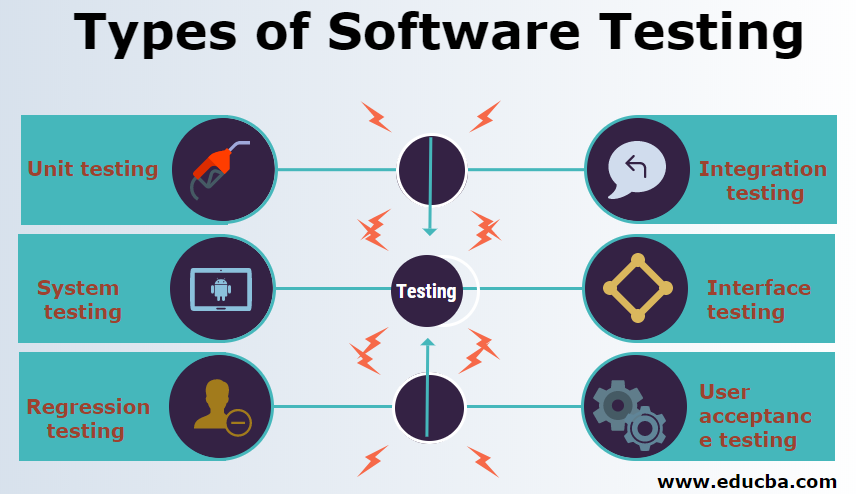Updated March 28, 2023
Different Types of Software Testing (List)
Software testing is the process of testing software to ensure that the software is bug-free. Testing is performed using different techniques like test cases, automation, programs, tools, etc. There are various types of software testing. Which types of testing are performed depends on the developing phase of the software. Each type of software testing has its own unique features, advantages, and disadvantages. In this article, we are going to discuss the various types of software testing.

Types of Software Testings
There are two main types of software testing – functional testing and non-functional testing. Each of them has its type of testing.
a. Functional Testing
The main goal of this testing is to test the functional area of the software or product like it is working properly or not; it’s all functions are properly developed or not.
Functional testing involves the following testing types are given as follows:
- Unit testing
- Integration testing
- System testing
- Interface testing
- Regression testing
- User acceptance testing
Let’s discuss those functional testing types one by one:
- Unit testing: In unit testing, individual components of software (called as a unit) are tested. This testing is performed to ensure that each unit of software is working properly and meets the specified requirements. As it is a small component, unit testing requires only two or three inputs.
- Integration testing: In integration testing, all the small units that are separately tested are combined and tested as a whole. The main goal of this testing is to find errors while interacting with other units.
- System testing: In system testing, completely integrated software is tested. The main goal of this system testing is to check whether the developed systems meet users’ requirements and expectations.
- Interface testing: In interface testing, communication between systems is tested. Suppose a new website is developed; components of this website could be its database, server, GUI, etc. Interface testing checks that the communication between those components is working properly or not.
- Regression testing: In regression testing, developers test the stability of the software or product in various environments. The main goal of this testing is to test whether the software works efficiently in different types of environments or not. Regression testing also ensures that the changing in one part of the code does not impact other functionality of the software code.
- User acceptance testing: User acceptance testing is a type of software testing where the system is tested for acceptability. This testing aims to identify whether the system meets users’ requirements, Whether the user accepts the system or whether it is ready to deliver in the market.
Under user acceptance testing, the following types of testing are done.
- Alpha testing: It is a common type of software testing which is widely used. The main goal of this testing is to find all possible errors before releasing them to the customer or into the market. This testing is performed by the testing team at the developer site. Alpha testing is performed at the end of the software development phase but before the beta testing.
- Beta testing: Beta testing is also known as the last stage of testing. The users do it. After the product or software is developed, users are given to provide feedback on the same. Continuous feedback from users is collected, and issues are fixed.
b. Non-functional Testing
It is another type of software testing where the non-functional area of the software is tested to ensure product quality. The main goal of this testing is to test the performance of the software, quality assurance of the software and measure all performance factors like storage ability, stress ability, loading ability, response timing, etc.
Non-functional testing involves the following testing types:
- Documentation testing
- Installation testing
- Performance testing
- Reliability testing
- Security testing
Let’s discuss those non-functional testing types one by one:
- Documentation testing: In documentation testing, documents are evaluated to check the requirements of the software. Documentation includes various test cases, test plans, approaches, and strategies. This testing helps to evaluate the test coverage and required test efforts.
- Installation testing: Installation testing is a type of software testing that focuses on what users need to do to install software and successfully set up the working environment. This testing process is done on partial, full, or upgrades install processes on different operating systems under different environments.
- Performance testing: Performance testing ensures that all software applications perform well under expected workloads. Underperformance testing, the following types of testing are done.
- Load testing: This testing is used to evaluate the behavior of software or system at different types of workloads
- Stress testing: Stress testing is used to evaluate the behavior of software or a system at or beyond the limits of its workloads.
- Endurance testing: This testing is used to evaluate the behavior of software or system when the same type of workload is given continuously.
- Spike testing: Spike testing is used to evaluate the behavior of a software or system when some workload is continuously increasing.
- Reliability testing: In reliability testing, the software is continuously tested to find errors before releasing the software in the market. Reliability testing ensures that the software is error-free and reliable, and ready for delivery.
- Security testing: In security testing, the security of the system is checked to avoid the loss of essential data. Security testing ensures that the system or software is secure from unauthorized activities.
Recommended Articles
This is a guide to Types of Software Testing. Here we have discussed the basic concept with two types of software testing, i.e. functional and non-functional testing. You can also go through our other suggested articles to learn more –


